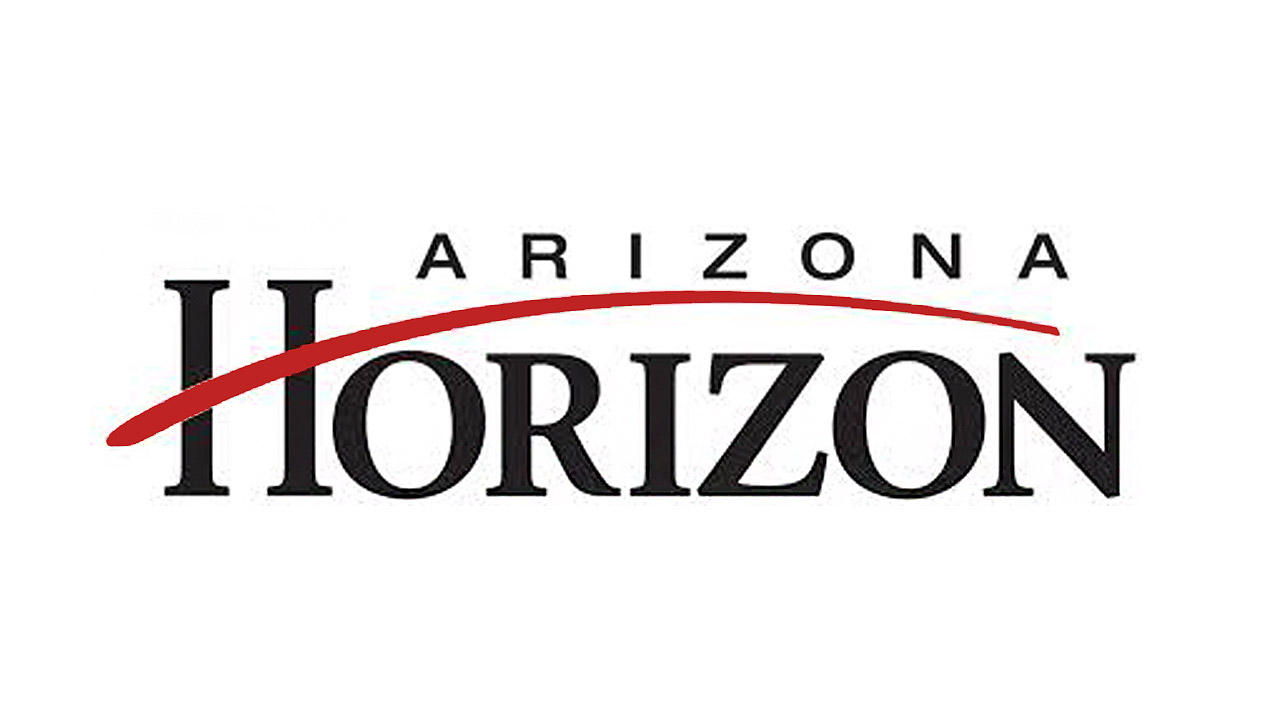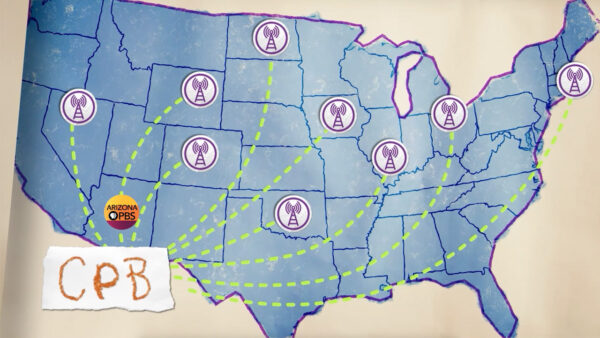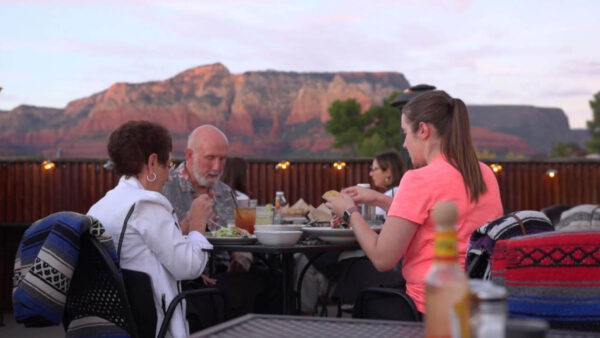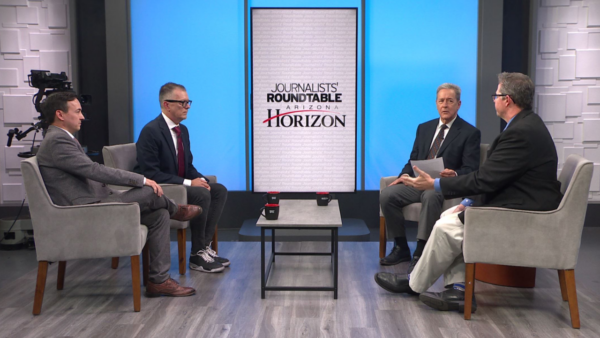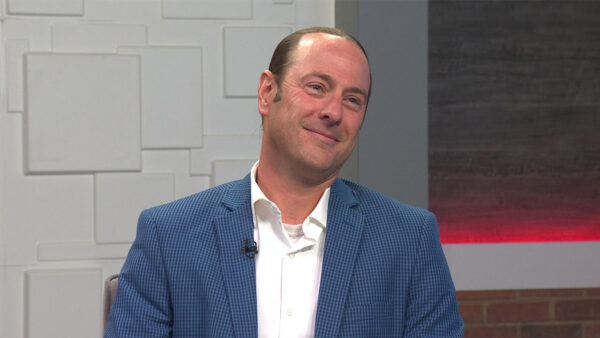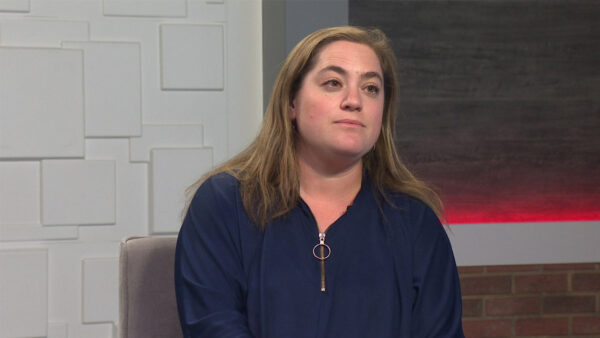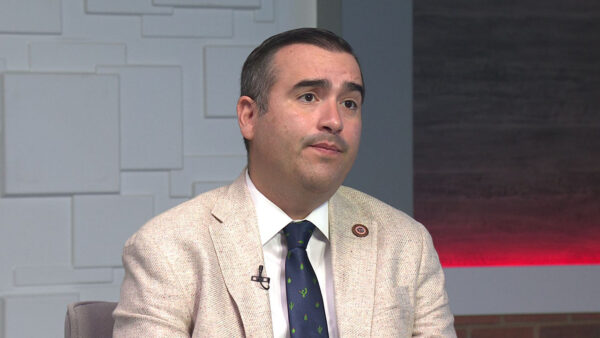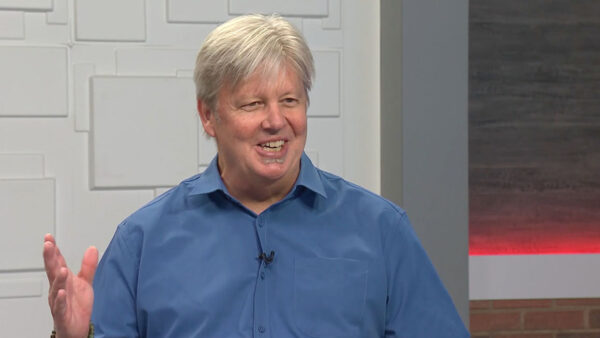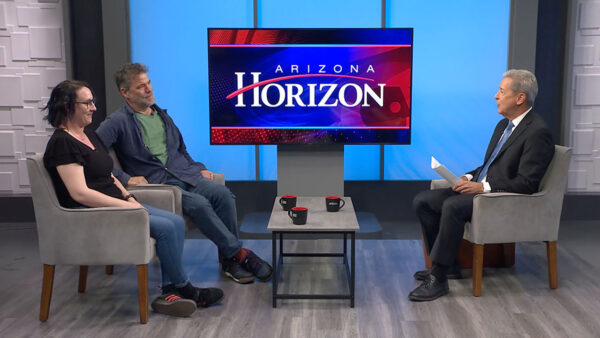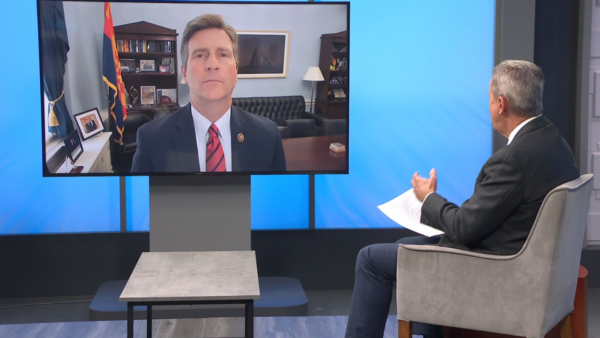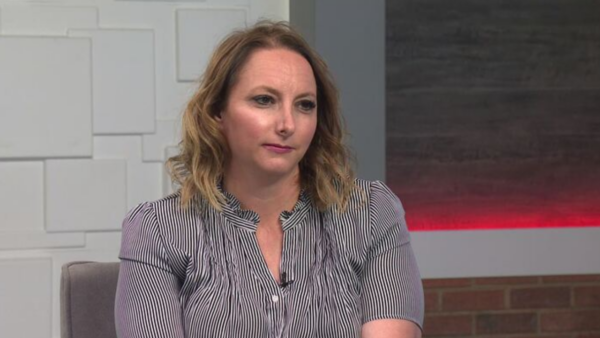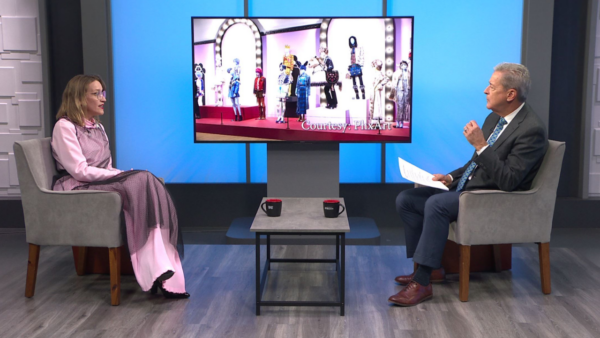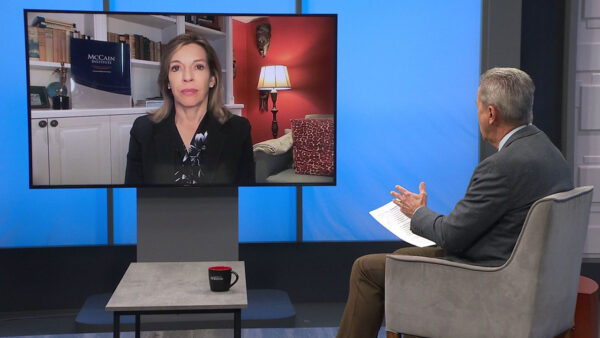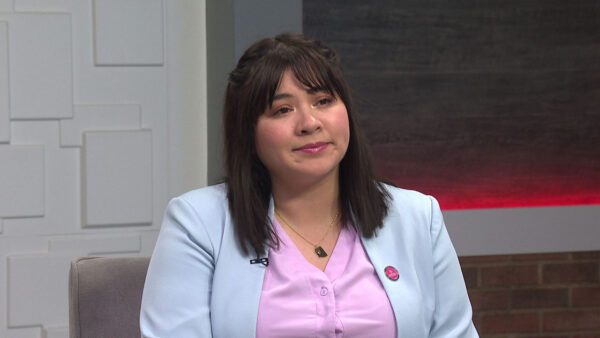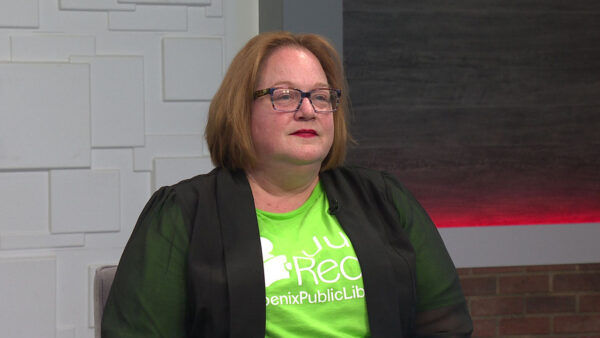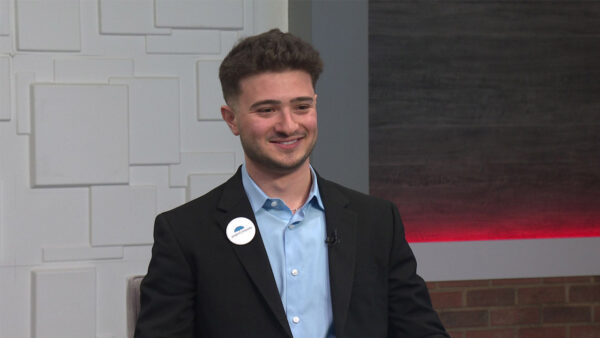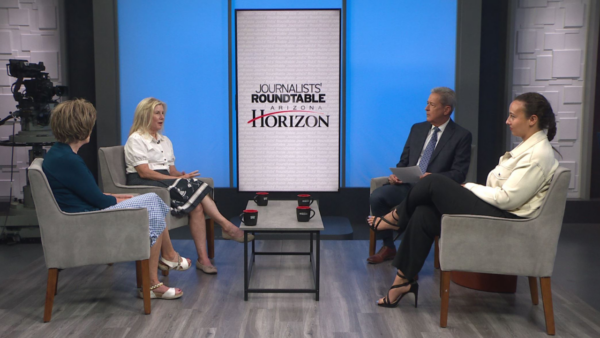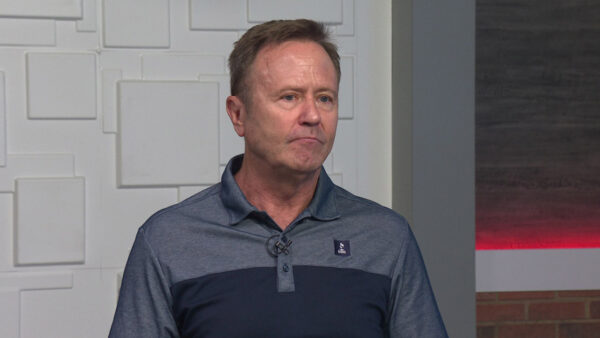Last year our state experienced a whooping cough epidemic. This year there is an outbreak of mumps in the Midwest. The introduction of vaccines has helped to control these types of diseases. Now researchers are working on a vaccine for the avian flu virus. We talk about this and other topics related to immunization with Dr. Anne Schuchat, Captain, U.S. Public Health Service and Director of the Centers for Disease Control and Prevention’s National Immunization Program.
Michael Grant:
Tonight on Horizon, will Mesa voters elect their first raise in city sales tax in years? And the whooping cough. We'll visit with a representative from the Centers for Disease Control. Good evening. Thanks for joining us tonight on Horizon. I'm Michael Grant. Next week on May 16 voters in several cities around the valley are going to be considering candidates and issues. Here is a rundown on some of the more significant races and proposals.
Larry Lemmons:
In the town of Buckeye's general election two candidates are in contention and a runoff for mayor. In Chandler, voters will choose two council members -- members. Litchfield Park runoff elections will determine a council member. Mesa voters will consider four items. Proposition 101 would create a full-time city auditor. Question one would increase the city's sales tax. Question two would authorize the primary property tax. In Paradise Valley, a runoff election for town council will involve two candidates. Also proposition 400 raises the town's expenditure limit. Proposition 401 allows the city to sell public property valued in excess of $500,000. In Queen Creek, two candidates are also in contention for town council. Scottsdale will determine a council member and will vote on proposition 402 which would raise the expenditure base in the city. In Tempe, five bond issues will be considered by voters. They will pay for water and sewer improvements, street improvements, law enforcement, fire protection and community services., park improvements and a library. Finally in Tolleson, two propositions will be on the ballot. Proposition 404 would create the 91st avenue preservation area. Proposition 405 would create a monument for the preservation area.
Michael Grant:
As we just mentioned, Mesa's going to be asked two large questions. Should the sales tax be raised from 1.25% to 1.75 and should the city levy a property tax. The city says it faces $25 million worth of budget cuts. Larry Lemmons takes us to Mesa where a downtown face-lift has had a mixed reception.
Larry Lemmons:
City workers in Mesa are repairing the streets after work done to repair a sewer line at Southern and Stapley. Some in city government say this infrastructure repair is one of several justifications for raising the city's sales tax and passing the city's first primary property tax since 1945.
Mike Whalen:
So the employees have not had a pay raise in the last two years. We have eliminated some 450 positions over the last three years. Employee morale is at the lowest I've seen in my 35-years with the city. Our maintenance in our parks are down. After school programs have been cut. The overall appearance of our roadways our infrastructure is starting to suffer. It's just a city that continues to grow with about 1,000 residents a month, yet the financial impacts cause us not to be able to keep pace with the needs of a large city.
Larry Lemmons:
But opponents of the passage of question one and two on the ballot May 16 say the city has only itself to blame for a budget shortfall.
Tom Rawles:
The reason that the police and the fire are suffering is because we're diverting so much money from the essential functions of government like police and fire, streets, libraries, parks and recreation into things like art galleries, museums, subsidized art classes and those kinds offerings. If we quit spending money on all this nonsense, all the stuff around the edges we'd have more than enough money for our core functions.
Larry Lemmons:
When Mesa councilman Tom Rawles uses the word nonsense he's referring partly to the refurbishing of the downtown area including the new arts center.
Tom Rawles:
Because it's Robin Hood in reverse, this is the social and economic elite of Mesa trying to force everybody else to pay for the things that they want. Whether it's a $94 million arts center or a specific kind of downtown with $600,000 pedestrian pathways that cover just one block or aquatic centers or museums, they want everybody else to pay for the things that they think they need in toward order to have a high quality of life.
Mike Whalen:
It's easy to criticize cities for making mistakes. As we look across at our arts center that was voter-approved. That money has nothing to do with the current state of the budget here in Mesa today. As far as the appearance of downtown, what Mesa tried to do was to recreate a downtown that people wanted to come to. I think we've done that. I think the city infrastructure is in place and now I think private business will come to the town center and make it a vibrant community.
Larry Lemmons:
Mesa voters got rid of their city property tax back in 1945 when the city owned its own utility and raised rates to cover the shortfall. Mesa was smaller then.
Mike Whalen:
1945 I believe the city was about 20,000 residents and we owned our own electric utility. That's why the council at that time felt it was not necessary to have a property tax. Mesa has grown to over 125 square miles and a population of almost 460,000 people. A revenue base just is not there any longer, which is the sales tax base. In the valley itself every major city has a property tax, both the primary and secondary. This issue is a primary property tax, which would cost the average resident less than $10 per month.
Tom Rawles:
Mesa used to be 50,000 people. It's now 450,000 people. All of those people moved here before we had an arts center, before we had all those amenities. The reality is this is a great environment, a great economy. People will come regardless. And the fact that we don't have a property tax is actually a selling point. It actually emphasizes how wisely we can spend money if we do it the right way.
Larry Lemmons:
Some opponents of the two questions say the private sector should pay for the amenities in question.
Tom Rawles:
Government exists to secure our freedoms, not our happiness. The government in Mesa has gotten into the happiness business. If somebody wants to have a museum then the people who use that museum and care about that museum and want that museum should voluntarily support it, build it, sustain it. It's not a question whether you take money from the power of taxation and force people to support things they don't want. I would do it with budget cuts to get it through this period and then have these same amenities but have them built and sustained by the private sector so that it's done the right way.
Larry Lemmons:
Some supporters of the question say if revenue isn't raised, cuts will continue.
Mike Whalen:
Well, the cuts that we've made this fiscal year of $25 million will continue on. And when you look at the inflationary value of 3 to 4 to 5% it could be 26 million next year, 27 million the year thereafter. I worry about the property values for the owners of homes in Mesa. I worry about the decay of our inner city. In order to have a city that attracts business, businesses like the nice amenity of the city offered, libraries and parks and recreation programs. Without that I'm fearful for the future of Mesa.
Michael Grant:
Joining us now to talk about the issue, the vice mayor of Mesa, Claudia Walters and also here is Mesa councilman Tom Rawles. We can rehash everything we just saw. Welcome to you both.
Claudia Walters:
Thanks.
Michael Grant:
Claudia, give me your -- why should Mesa voters next Tuesday vote for increasing their taxes?
Claudia Walters:
You know, we moved to a particular kind of a community 21-years ago. It had parks, libraries -- libraries, summer programs for the kids. All kinds of great streets and resources for families to live there. We simply cannot keep up with that anymore. Along with the essential services as the community continues to grow. We need to have a stable revenue source for Mesa and we don't. We have a cyclical revenue source and it's hurting us. Additionally we are losing our sales tax revenues to surrounding communities.
Michael Grant:
Is that time primary problem in your opinion? Because obviously Mesa is still growing. There's a lot of economic activity going on. Is it these guys in chandler and Gilbert are ripping you guys off?
Claudia Walters:
You know, how dare they build malls and have people go there. Then we went and built freeways that made it easier for them to go there. And while we can sit around and say "shop Mesa" we've been having a free lunch for a number of years based on people from other communities coming and shopping in our community. It's been great while it lasted. But there is a balancing act going on right now and Mesa shoppers aren't all staying home and people who live in neighboring communities are shopping closer to home.
Michael Grant:
Okay. Tom, why are you -- we already saw portions of why you are opposed. Do you want to tighten that back up?
Tom Rawles:
Well, in summary I think the city continue today -- continues to do things that are not essential sectors of government. We have not a decrease in our sales tax per capita but we have a slower growth. When you add in the quality of life sales tax passed back in 1998, we still have an increase in our per capita sales tax revenue. So that should be enough money. When you couple that with the state shared revenue that we receive from the state and the 75 to $85 million a year that gets transferred into the general fund from the utility enterprises. Other cities use utility revenues but nowhere near to the extent that we do. That's been our substitute for property tax. What they're talking about doing is not doing away -- if this property tax passes they're not going to do away with the utility tax. In fact it's still scheduled -- the rates are still scheduled to increase. So if we would stop doing the things that government shouldn't be doing, I believe that there is enough money available for the city of Mesa to be a prosperous, worthwhile, fun, good place to live.
Michael Grant:
What's wrong with that argument?
Claudia Walters:
Well, for one thing his numbers don't work. Mr. Rauls opposes both the sales tax and property tax and he has absolutely 2340 way of funding the streets in Mesa, coming up with the match for the prop $400. Also we have failing infrastructure right now. And whether or not we pass this or not the infrastructure is getting older and older and we have to have a payoff funding it. Bypassing the property tax we free up some of that utility money to repair that infrastructure. It needs to be done it. Has to take place.
Michael Grant:
Obviously the city sunk a lot of money in the arts center and downtown, those kinds of things. I think one of the city's responses is, yeah, that was paid for, though, by the quality of life tax that time voters approved. But there are ongoing operations costs associated with that are there not?
Claudia Walters:
There are ongoing operations costs. If you go back and look at the ballot language it actually said build and operate that. Was figured in to all of the calculations with the quality of life tax. The quality of life tax remains in balance. It's the general fund that is not in balance. If the quality of life tax had never been passed and we had not built the arts center we would still have the same budget problems today that we have. The place where we're out of balance is in the general fund. I'll tell you what we wouldn't have. We wouldn't have an arts center, we wouldn't have hired -- we will have by the time we get to the end of this cycle hired 120 new police officers, we won't have hired the firefighters. The quality of life tax really kept us going through a tough time.
Michael Grant:
To the extent, Tom, though, that Mesa voters came out in the late 1980's and said, hey, that's something that we want the city to do. We want to spiff up downtown. We want to drop in some new facilities so we're not constantly driving to downtown Phoenix, whatever motivated them. Isn't that just the city council sort of and -- acting on the voter intent?
Tom Rawles:
The ballot said do you want to approve the quality of life tax for new police officers, new firemen. Nobody said the arts center was going to take -- be a $100 million facility. I can't remember how I voted on that tax in 1998 but if I voted for it which I probably did it was because of the police and fire component not the arts center component. There's still a general fund subsidy sustaining that arts center of about $2.3 million. The quality of life operational money covers about 50% of the cost, the general fund has to pick up the rest of the operational amount. The general fund is also subsidizing $1 million worth of art classes where people are taking classes on how to play the guitar and learn how to throw a pot on a wheel. All good things but not the kind of things that government ought to be coercively taking tax dollars to pay for.
Claudia Walters:
But not new things in Mesa, Tom. These are things that have been around for 30-years or more. And the subsidy in the general fund has not increased. Because the arts center was built. So to blame the arts center is factually incorrect. The place we're out of balance is in the general fund, which provides more than half of that money. It's for police and fire is our highest priority.
Tom Rawles:
Michael, I've never blamed the arts center. I came on to the council after it was built. I've never said that's the scapegoat. What I said is that there are things that we are doing that we shouldn't be doing. And the subsidy of the cart classes and other things are that. And as far as the streets go, I said in October that I would support retaining the sales tax at 1.5 or 1.55 in order to cover the need for the streets and the prop 400 match for the freeways. So it's just the fact that we've gone to .175 rather than .150 and we're trying to get $30 million on top. So I was prepared for a new tax to deal with the streets and the prop 400 match.
Michael Grant:
Basically what Tom's saying is that there's some fat that can be cut if these don't pass.
Claudia Walters:
We have been cutting fat around Mesa for the last several years. And in fact, we are looking at things have been to do with the arts center and teaming up with Maricopa community college district. Many of the things he's addressing we have been addressing as a council. We have cut a lot of fat. We're at core services now. We've cut hours at the library. I would respond by saying that while Mr. Rauls said he would support that, that doesn't address the problems in the infrastructure. We know that we're failing lines under the street and we have got to replace those lines. His numbers simply don't work.
Michael Grant:
Claudia Walters, vice mayor, thank you for joining us. Tom Rawles, nice to see you again. Last year our state experienced a whooping cough epidemic. This year in the Midwest there is an outbreak of mumps. Vaccines have helped control these types of diseases. Is there a vaccine in the works for the avian flu virus? Horizon's Merry Lucero sat down with Dr. Ann Schuchat to talk about that and other topics related to immunization.
Merry Lucero:
Let's talk about coverage. Where does the nation stand with infants and children receiving the recommended immunizations?
Dr. Anne Schuchat:
You know, we set a target for the U.S. for 2010. Our healthy people 2010 objective to try to reach a coverage level of 80% for the full series of childhood immunizations by age 2. Last summer we were proud to announce that we have finally reached that level. We hit 81%, just over the target. For each of the individual sack evens we would like to get up to 90% coverage. For most of the childhood vaccines individually we're at 90% or very close thereof.
Merry Lucero:
Where does Arizona stand?
Dr. Anne Schuchat:
Arizona has done a tremendous job of improving the immunization coverage in preschool age children or children up to that age point. So they are just now at 79%, very close to the 80% target. They've had really impressive improvement over the past 5-years and they had dramatic improvement in the coverage of Hispanics in the state.
Merry Lucero:
Last year we had an epidemic of whooping cough. Where are we this year?
Dr. Anne Schuchat:
Whopping cough is one of those diseases you don't hear that much about but it's a really horrible disease. Arizona went through a big outbreak last year and had a pretty intense response to that with some vaccination came campaigns to try to help with the problem. One of the really exciting things about whooping cough is we have a new tool to help prevent that disease. It turns out that whooping cough is really serious in young infants and babies. They are often hospitalized or can get pneumonia. But adults and teenagers can also get it and spread it to the youngest members of the family. So the new tool that we have is a booster vaccination that's safe and effective in teens. So we have a new recommendation that all teens should be getting the whooping cough booster dose. And we also recommend it now for healthcare workers because we can have problems in the hospital setting. And we're recommending it for adults to replace the tetanus and dip here yeah booster dose, instead to use a whooping cough booster dose during adulthood, just one dose. So we hope that by preventing whooping cough in adults and teens we can really protect the youngest kids who are so vulnerable from this infection.
Merry Lucero:
Are there any new strategies for administering the influenza vaccination?
Dr. Anne Schuchat:
Yeah. There really is a lot of exciting information coming out about influenza and how it can do better with protecting people throughout the life span against influenza. Influenza is a serious in New Mexico. It's very common. It's most serious in the extremes of age and the very old or the very young. Unfortunately our vaccines don't work quite as well in the very old or very young so we looked to lots of strategies to protect them. Traditionally we've been focus on vaccinate the elderly and people with medical complications who may have really severe cases of flu if they get the flu. More recently we're looking at other opportunities to protect the community and individuals. A couple of years ago we recommended a routine vaccination with influenza for children in the 6 to 23-month age group to protect them base they are at higher risk of hospitalization. Just this past February or January -- advisory expanded the pediatric flu recommendations and suggested pediatricians go all the way up to 59 months in using flu vaccine. Children in the 24 to 59-month age group are not at high risk of hospitalization but they're at high risk of disease, for out-patient visits, antibiotics, all kinds of things. We're optimistic that by protecting the children we'll reduce influenza in that group and we may have side effects of protecting the elderly as well.
Merry Lucero:
The news is the outbreak of mumps in the Midwest. What's going on?
Dr. Anne Schuchat:
We've been suffering from quite an outbreak of that in the Midwest. It started in Ohio on college campuses there. A lot of us don't really like to think about what goes on college campuses in terms of the close quarters and the active interaction that kids have. We have had a recommendation that everybody should get two doses of measles, mumps and rubella -- rubella vaccine but some colleges say you can't get in without showing proofs of the doses and some have been more lacks on that. There have been outbreaks in the United Kingdom in the -- Kingdom in the past couple years. The type of mumps in Iowa and the surrounding states turns out to be the same strain of much mumps as what was in the United Kingdom. It's possible that time virus came into the country perhaps from Europe, from England, and took hold in this college and spread within the college communities because we can't have -- didn't have quite as high coverage as we needed to have. The mumps vaccine is good. One dose is 80% effective. Two doses is 90% effective. But even with the 90% effective vaccine, 10% of people will still be vulnerable or susceptible to mumps if the virus starts to circulate. So we think this is a couple bad luck stories of virus coming in, coverage not being perfect and even a 2 dose schedule not being as perfect as we'd like. On the other hand, if we didn't have really high immunization rates in this country this outbreak would have been much, much worse. Fortunately there haven't been too many severe cases, not too many that needed to be hospitalized. So, I think we're very lucky to have the strong program we have. We're looking in other states for spread and we're seeing it in some states and not in others. It's the kind of thing we always need to keep our guard up against. Because vaccine from other diseases can come back. I think it's important for Arizona and all the states to have really strong surveillance home monitoring programs to prevent vaccine preventable -- and to make sure we have high immunization rates so if they do come in they're not going to spread. The Arizona department of health services is very active in looking for infections right now with mumps and all the time with things like polio or measles or German measles to make sure we don't get those diseases that we think we're -- we've taken care of.
Merry Lucero:
The big disease everybody is concerned about is avian flu. Is there vaccination in the works for human immunization for avian flu?
Dr. Anne Schuchat:
This situation is really serious. I think people wonder is it serious, are people just talking about it all the pipe time? It's a really bad problem in birds right now. We have had it spread into many countries in terms of the migratory birds or poultry. That's a big agricultural problem with the wildlife concern. Fortunately so far human cases of the avian flu virus have been quite uncommon. When those cases have occurred they've been extremely severe. More than half the people who have gotten this new virus have died from the infection. So it's something that we're taking very, very seriously. The U.S. government invested resources into development of a vaccine against the h 5 n 1 avian flu virus that we keep hearing about. So our first product has been developed and tested in people. There's a second product that that's now being developed because the first product was developed against the strains of the bird flu that were circulating in Vietnam. There are now different strains that are circulating in Indonesia and the U.S. Government is investing in vaccines against that newer strain of bird flu. So we don't -- we don't have a bird flu virus vaccine for humans yet but we're working on developing one.
Producer:
Voters in Scottsdale will soon decide on what some are calling the most important issue on the may 16 ballot, a spending limit override. That's how much Scottsdale city government can spend to provide services for residents and determine what city councils can do into the future. Details Tuesday on Horizon.
Michael Grant:
Wednesday we'll take a look at the governor's vetoes this session. Thursday we'll talk with the creator of the Laffer Curve, Arthur Laffer. Friday please join us for the week's recap on the journalist's roundtable. Thank you very much for joining us on this Monday evening. I'm Michael Grant. Have a great one. Good night.
Claudia Walters:vice mayor of Mesa;Tom Rawles:Mesa councilman;
